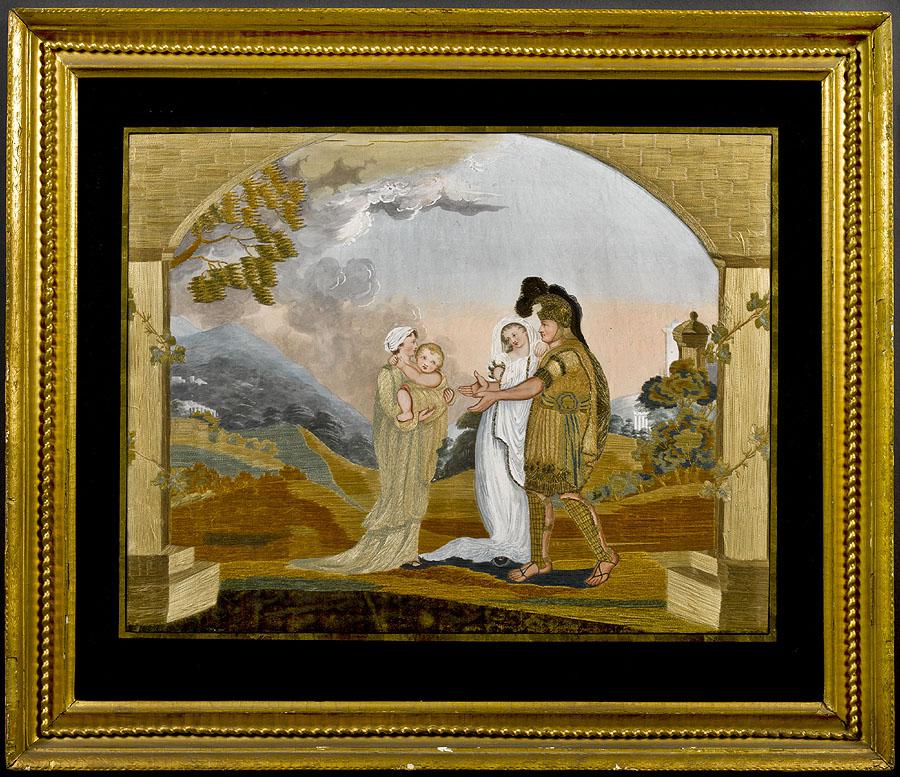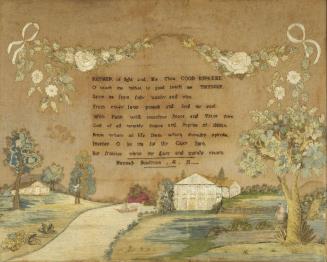The Parting of Hector and Andromache
EmbroidererEmbroidered by
Maria Bissell
(American, 1793 - 1848)
SchoolAttributed to
Royse School
(American, 1799 - 1824)
Date1810
MediumEmbroidery; silk thread, chenille yarn, velvet, and paint on a plain-woven silk ground; glass, black and gold paint, wood
DimensionsPrimary Dimensions (height x width): 26 x 30in. (66 x 76.2cm)
ClassificationsTextiles
Credit LineBequest of Silas Cornwall in memory of his wife, Mrs. Ida Evelyn Bissell Cornwall
Object number1934.6.1a,b
DescriptionNeedlework picture worked in brown, blue, khaki, tan, gold, yellow, white and light blue silk thread, light brown, metallic thread, dark brown and green chenille yarn, and brown velvet on a plain-woven silk ground, using satin stitch and other stitches; the picture is labeled "The Parting of Hector and Andromache/ M. Bissell/ 1810" (on original glass, now replaced). The picture shows a man and a woman standing to the right of a woman holding an infant; the man's arms are reaching out to the child. The women are dressed in classically styled dresses while the man is wearing military costume, including a helmet and shin guards. The figures are standing beneath an arch supported by a pair of ivy-wrapped columns. In the background is a mountainous landscape which includes buildings. The foreground is made of chenille yarn and applied velvet. The remaining ground, portions of the figures, and landscape are worked in silk thread and chenille yarn. Portions of the figures, some of the costume, and the distant landscape and sky are hand-painted onto the ground. The picture is behind glass that is painted black and gold at the edges (replaced). The frame (.b) includes one deeply curved band of molding with a rope-twist molding applied inside.
Stitches: The primary stitch on the needlework picture is satin stitch; it also includes flat, long and short, encroaching satin and some overlay work.
Condition: The silk thread has moderate fading. The glass is replaced. The backing is replaced.
Stitches: The primary stitch on the needlework picture is satin stitch; it also includes flat, long and short, encroaching satin and some overlay work.
Condition: The silk thread has moderate fading. The glass is replaced. The backing is replaced.
Label TextSeventeen-year-old Maria Bissell created an intimate domestic moment
from Homer’s Iliad. As translated by Alexander Pope, the Iliad became
one of the most popular classical texts read by educated women in early
America. Hector, prince of Troy, says goodbye to his wife, Andromache,
and their son, Astyanax (held by a nurse). The group is set pleasingly
off-center within an arched frame. An expansive painted background,
and minute details of classical dress and facial expression are depicted. As
evidence on the back of the piece reveals, Hector was originally clad in
shocking pink, with a lime green sash; the nurse’s robes were sky blue, and
Astyanax’s wrappings, light pink. Only Andromache’s painted white robes
retain their original brilliance.
NotesSubject Note: Homer's epic poem, The Iliad, tells the story of the Trojan War, fought between the Greek army and the city of Troy. Prince Hector was the leader of Troy's army. Early in the poem, he is able to visit with his wife, Princess Andromache, and their infant son, Astyanax. Lines 457-580 of Book 6 detail their meeting and farewell. This sampler may depict lines 457-474; in Robert Fitzgerald's 1974 translation, they read:from Homer’s Iliad. As translated by Alexander Pope, the Iliad became
one of the most popular classical texts read by educated women in early
America. Hector, prince of Troy, says goodbye to his wife, Andromache,
and their son, Astyanax (held by a nurse). The group is set pleasingly
off-center within an arched frame. An expansive painted background,
and minute details of classical dress and facial expression are depicted. As
evidence on the back of the piece reveals, Hector was originally clad in
shocking pink, with a lime green sash; the nurse’s robes were sky blue, and
Astyanax’s wrappings, light pink. Only Andromache’s painted white robes
retain their original brilliance.
"There his warmhearted lady/
came to meet him, running: Andromache,/...
...Hektor was her lord now,/
head to foot in bronze; and now she joined him./
Behind her came her maid, who held the child/
against her breast, a rosy baby still,/...
How brilliantly the warrior smiled, in silence,/
his eyes upon the child! Andromache/
rested against him, shook away a tear,/
and pressed his hand in both her own..."
This family's story ends in tragedy: Hector is killed by the Greek hero Achilles, the infant Astyanax is killed during the sack of Troy, and Andromache is taken from Troy as a captive. (Hudson 8/16/2005)
Source Note: According to needlework scholar Betty Ring, the figures in this composition were probably derived from The Parting of Hector and Andromache engraved by W. Durrell, New York, 1808, and used as the frontspiece in The Iliad of Homer, vol. 2, translated by Alexander Pope (Boston: Hastings, Etheridge, and Bliss, 1808). (Hunt 3/26/2007)
Status
Not on view
















